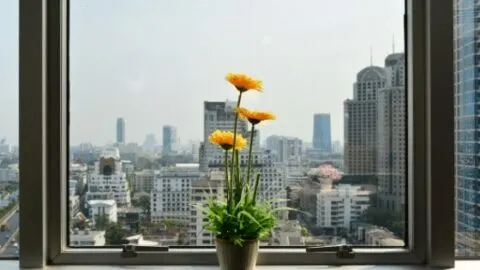Table of Contents
When reading plant care guides you will often hear the terms “bright indirect light”, “medium-light” and tolerates “lower light levels”, place in front of a “west-facing window” amongst others. But what do they actually mean and where in your apartment can you provide “bright indirect light”?
This 101 guide about light levels for plants is here to bring light into the dark, explain the different light levels and will help you to better understand where to place your plants in an apartment.
Light
Light is part of the 6 ingredients plants need to do well which are: light, water, humidity, healthy soil, warm temperatures and nutrients. The right balance for each of these is key. Too much and most plants will suffer. Too little of any of these and plants cannot survive.
Light is needed for photosynthesis and the right light levels for plants needs to be studied as it differs considerably from plant to plant. Light is needed for plants to conduct a chemical process that turns it into sugars using light, water and carbon dioxide.
The right light level for plants is so important as too much light might hurt your plant as much as too little. Instead of thinking about where your plant will look best and fit best in terms of interior design, you need to know the needs of your indoor plants.
These needs are determined by the natural habitat of each plant as this is the determining factor of what each plant needs to survive and thrive.
Light Levels for Plants Cheat Sheet
We created a handy cheat sheet for you so you will never have to guess again about where to find the needed light levels for plants.
Did you know that the distance from aa window can considerably influence the amount of light a plant gets? Moving a plant 2-3 feet can reduce the light level by more than 50%!
In addition, light through a window is at least 50% reduced versus light outdoors.
It tells you where your houseplants get direct light, where bright indirect light reigns and where the best spots are for your lower light indoor plants and medium light plants. The ultimate light levels for plants cheat sheet.
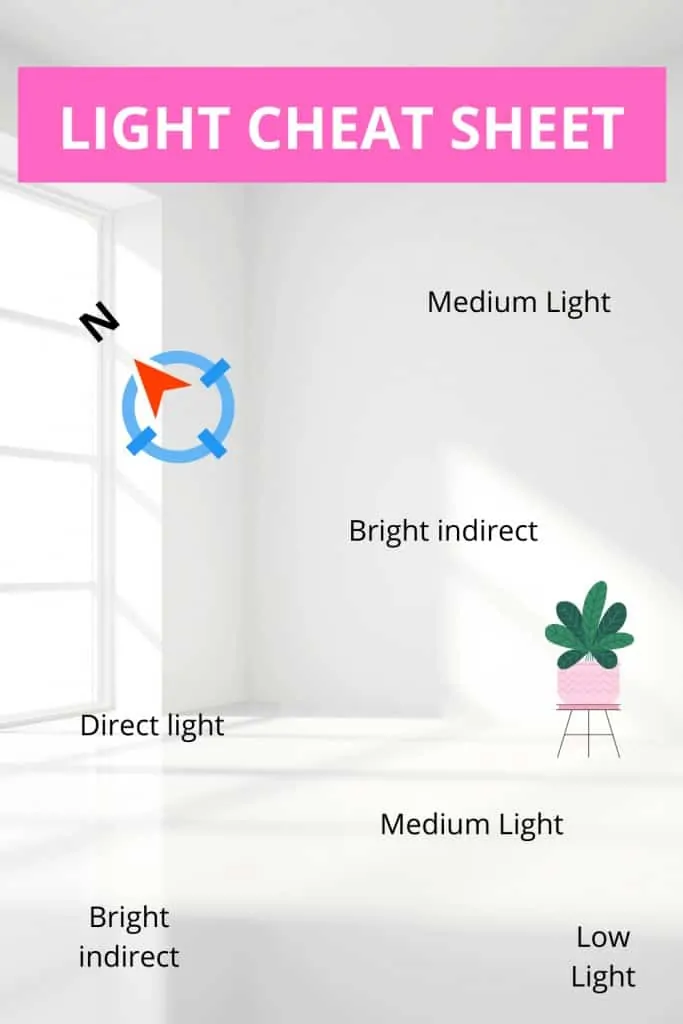
Light Levels For Plants Cheat Sheet
Bright Direct Light
Bright direct light is light that shines directly onto your houseplants. South and west-facing windows will get the largest amount of bright direct light. Usually, plants that need bright direct light will need at least five to six hours of sunlight if not more. The amount of direct sunlight is significantly reduced in autumn and winter.
2000-5000 foot candles of light are considered bright direct light.
Read about the best plants for high light.
Let’s now look into bright indirect light.
Bright Indirect Light
When studying light levels for plants, Bright indirect light is probably the most difficult to grasp. But don’t worry. The concept is pretty easy to understand.
Bright indirect light is light that does not directly land on the leaves of your plant when sent from the sun. They land on something else first and then bounce off.
1000-2000 foot candles of light are considered bright indirect light. Bright indirect light produces defined shadows.
Here is a list of indoor plants for bright indirect light:
- Kentia palm
- African Violet
- English Ivy (Hedera helix)
- White Bird of Paradise
- Chinese Evergreen (Aglaonema)
- Peace Lily (Spathiphyllum)
- Maidenhair Fern (Adiantum)
- Monstera adansonii
- Peperomia hope
- Begonia maculata
- Philodendron Birkin
Medium Light
Well, what is medium-light then? Medium-light is light that you get in a bright room but that is not direct. Medium-light is the level of light plants receive when placed somewhat away from a window.
250 to 1000 foot–candles is considered to be medium light.
Plants growing well in medium-light:
- Spathiphyllum
- African Violet
- Begonias
- Boston Fern
- Croton
- Dumb cane
- Moth Orchid
Let’s now move from the medium-light to the low light division. That’s an amount of light few plants do fine. But the plants that do are mostly also quite hardy and easy to care for.
Low Light
This is the category of light only the hardiest and sturdiest can tolerate and few indoor plants are thriving under low light conditions.
50 – 250 foot candles are low light conditions.
Some plants that do well in low light are:
- Snake plant (Dracaena trifasciata)
- Dracaena
- ZZ Plant
- Spider plant
- Lucky Bamboo (Dracaena sanderiana)
- Arrowhead plant
- Heart-leaf philodendron
Please consider to check out our vast list of 20 low light houseplants.
No Light
There is no plant in the world that can grow with no light. Actually that is not 100% true. Faux or fake plants will do quite well under these circumstances. If you cannot offer even the slightest amount of direct sunlight or very very little light investing in a fake plant might be your best choice. An alternative would be to use grow lights or some other artificial light source.
0-foot candles, 0 plant growth.
Windows
Choosing the right-facing window for your indoor plants is crucial. Not all window directions are equal as the sound goes up in the east and sets in the west. East-facing windows will, therefore, have a couple of hours of direct morning sun while the south-facing windows will have bright direct sunlight for multiple hours in the afternoon.
Let’s now look into the different light levels for plants depending on the window direction they are placed in.
Window Direction
The window direction plays a major part in how much light your plant gets and also whether the majority of light will be direct or indirect.
In addition, as the sun goes up in the east and sets in the west, the difference in direction of your windows also impact if your plants get more morning or afternoon light.
In this handy guide, we will highlight all directions and talk about the amount of light and also when the exposure of light is the biggest.
We further listed plants that do well for each window direction for you. Different plants have different needs. From the level of water to the amount of humidity as well as the right soil, the right amount of light is yet another factor that needs to be taken into account. As it plays a major role in the photosynthesis, it arguably is the most important factor of all.
Let’s start with the north-facing window.
North Facing Window
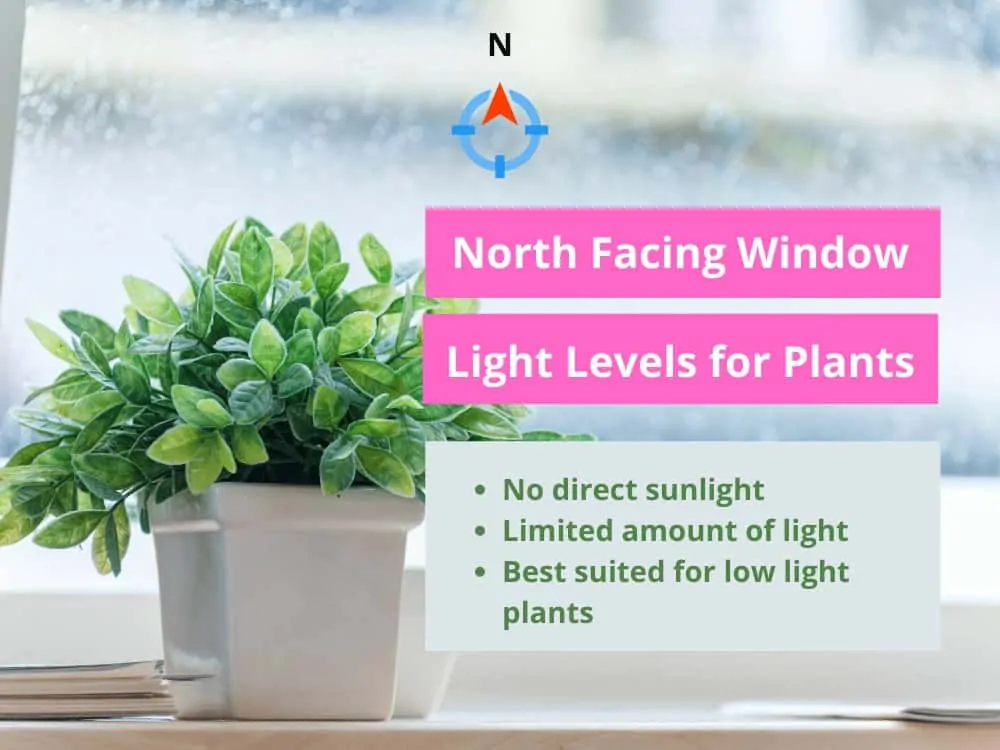
North facing window for plants
The north-facing windows are windows without direct sunlight. This means that plants receive a limited amount of light. However, this doesn’t have to mean that these windows are not suited for plants. Many plants such as plants growing in jungles are perfectly fine with limited light and will thrive even in north-facing windows.
Good examples of plants that do well in front of north-facing windows are:
- ZZ plant
- Snake plant
- Heartleaf plant
- Arrowhead plant
- Spider plant
- Monstera Adansonii
- Monstera Deliciosa
- Alocasia Frydek
You can also consult our extended list of 20 low light houseplants.
East Facing Window
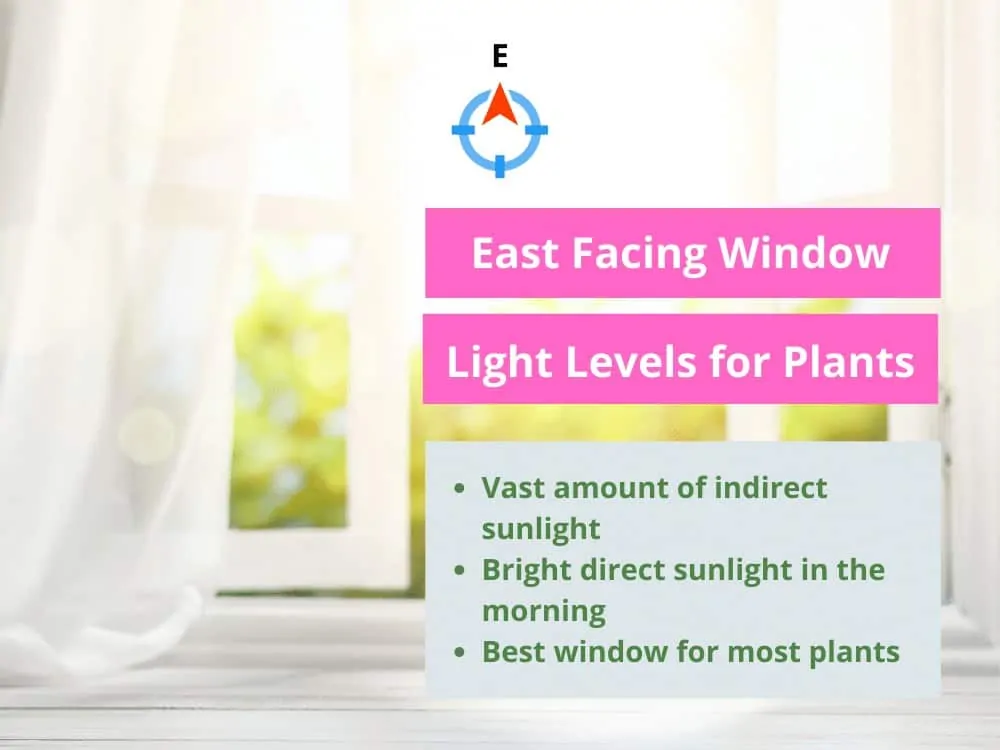
East Facing Window Light Cheat Sheet
These are the windows that get a vast amount of bright indirect light. In the morning, east-facing windows get a couple of hours of direct sunlight. Since it is in the mornings, many plants tolerate this kind of light as it isn’t as strong as direct light from the afternoon sun. In the afternoon, east-facing windows get large amounts of indirect light. Temperatures in an east-facing window are usually a bit lower.
For many many plants, this is the ideal amount and strength of light needed to grow well and produce nice foliage is bright indirect light. It is no surprise, that east-facing windows are the perfect spot to place most houseplants.
A list of plants to place in front of east-facing windows:
- Most palms
- Croton
- String of Hearts
- Fiddle Leaf Fig
- Pothos
- Ferns (Boston Fern)
- Peperomia Plants
- Pilea
East facing windows are generally considered to be the best windows to grow plants in front of. By placing curtains in front of the window you could dim the light level further if you have to but it is mostly not needed as many plants take a couple of hours of direct morning sun well.
South Facing Window
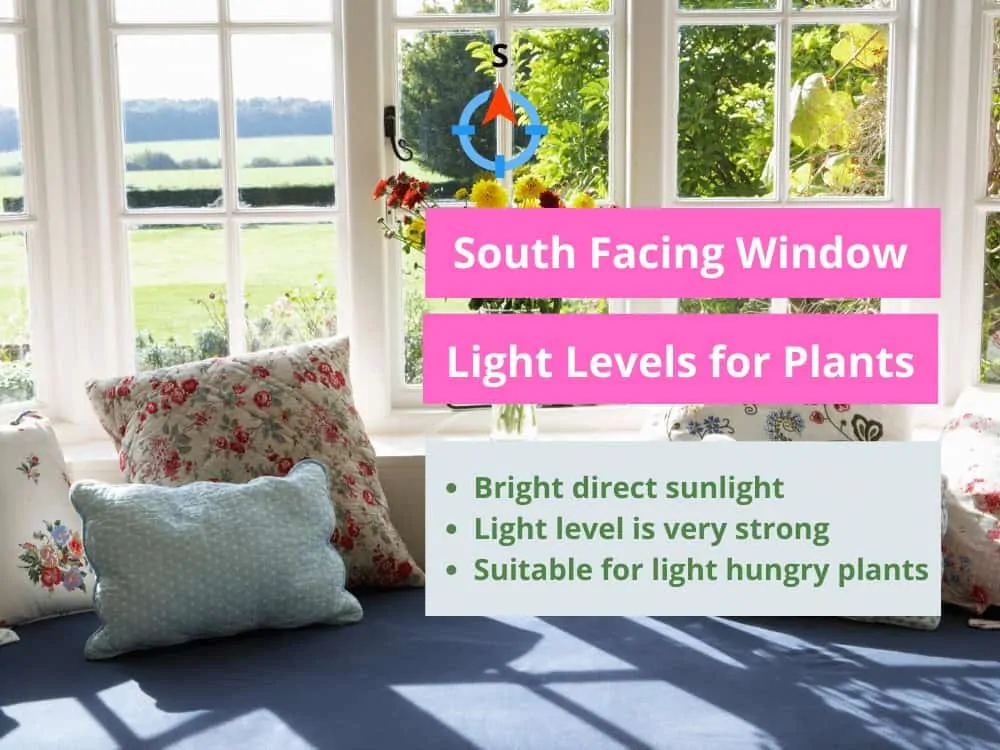
South Facing Window Light Cheat Sheet
South-facing windows will get bright direct light and lots of energy for plants. The light level will be very strong and although some plants might tolerate and even love it, you need to make sure that it is not too much light. What you have to consider is that the windows will magnify the light further and it will become even stronger.
When facing too much direct sunlight, some plants might show signs of leaf burn. Brown spots on leave and even holes might be indicators of too much direct sunlight.
Plants that can take large amounts of direct sunlight are:
- Aloe Vera
- Cacti in general
- Crown of Thorns
- Sempervivum (Hens and Chicks)
Don’t forget that you always have the possibility to shade your plants by placing curtains and fabric screens in front of the windows. This might reduce the amount of light arriving on the leaves of the plants considerably and can turn bright direct light into bright indirect light.
West Facing Window
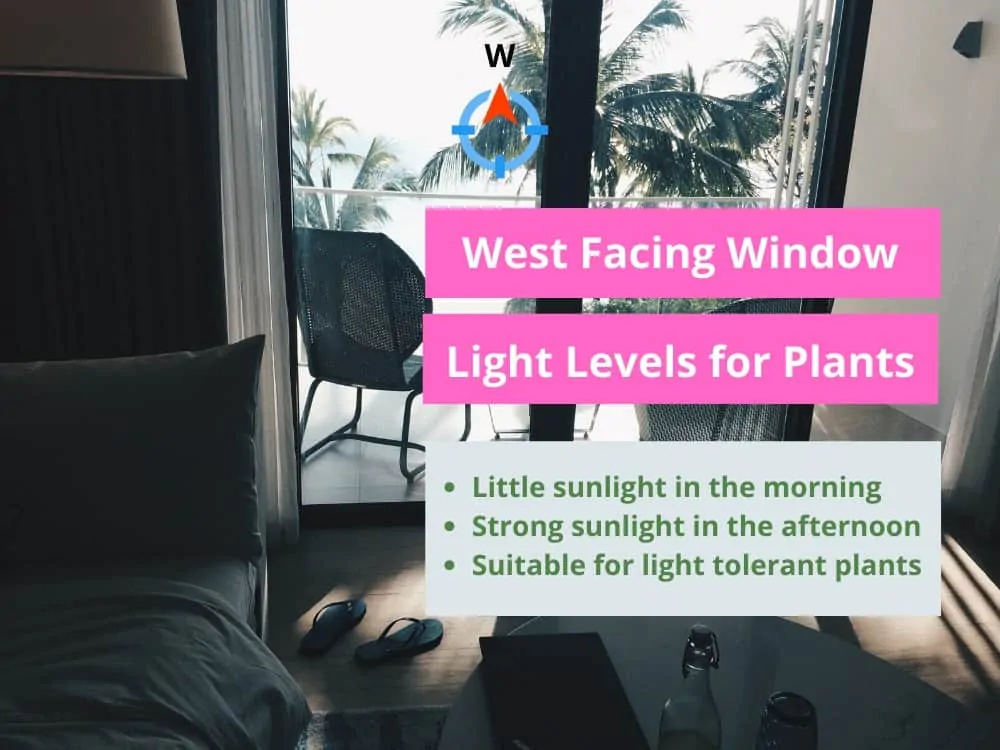
West Facing Window Light Cheat Sheet
As the sun rises in the east and sets in the west, west-facing windows will receive little sunlight in the mornings. On the other hand, a larger amount of sun rays will arrive in the afternoon and evenings. Therefore a west-facing window is best suited for plants that tolerate strong direct sunlight or afternoon sun well.
- Umbrella tree
- Aloe Vera
- Christmas Cactus
- English Ivy
- Geranium
- Air Plants
- Birds of Paradise
Read our in-depth guide about west-facing windows and even more suitable plants.
How to know if your plant gets enough light
Sufficient light will make sure your plants have lush green foliage for most plants. An indicator of insufficient light can be leggy plants. As an example, cacti get thin and grow tall.
Other plants such as Pothos will develop bigger spacing in between leaves. This is a good indicator that your houseplant is not getting sufficient amounts of light.
An indicator for too much light are burnt leaves or leaves falling off entirely. Burnt leaves turn brown and sometimes even develop holes where the sun rays have burnt through.
Or they can wilt considerably as the heat also plays a factor. It should not be forgotten that windows often act as sort of a magnifying glass and will increase the strength and warmth of the sun.
Light Levels For Plants Outro
By now you should have a good understanding of the different light levels for plants. What plants thrive under what conditions or levels of light, and what the different light conditions are for north, east, south and west-facing windows.
With this knowledge, you are well equipped to locate the best spots for your houseplants. Leggy plants and not growing houseplants hopefully become a thing of the past.
There are just two more important things to mention. The seasons play a major part in the amount of light your plants receive. Summer and Spring are obviously the months with the longest amount of sunshine whereas winter and autumn receive considerably less sunshine.
This has a profound effect on your plants and your houseplants will grow considerably slower in winter and autumn.
The second thing to mention is that you always have the opportunity to top up natural sunlight with grow lights. Especially in winter, it might be beneficial to make use of artificial grow lights as these will help your plants do better in the darker months.
Choosing the right grow light and strength and also the right distance are things you need to consider here. Please feel free to have a look at the grow lights in our shop. We made sure to source great and powerful grow lights that do not burden your bank account too much.
If you are looking for houseplants to put into your bathroom, you can check out our handy guide about the best plants for your bathroom.

Daniel has been a plant enthusiast for over 20 years. He owns hundreds of houseplants and prepares for the chili growing seasons yearly with great anticipation. His favorite plants are plant species in the Araceae family, such as Monstera, Philodendron, and Anthurium. He also loves gardening and is growing hot peppers, tomatoes, and many more vegetables.

